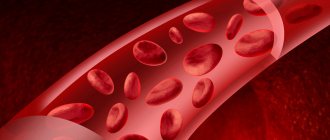To make an appointment with a doctor
Calling a pediatrician to your home
Our doctors
Our prices
The fluid state of blood in adults and children is maintained by the coagulation system and the system that resists coagulation. Normally, the ratio of plasma to blood cells is constantly in balance (approximately 55% and 45%), but in some cases it is disturbed. Thick blood in a child can cause serious consequences, and therefore requires special attention from doctors and timely treatment.
Causes
Thick blood in a child most often indicates dehydration. This can be caused by severe and prolonged vomiting, insufficient fluid intake, diarrhea, kidney failure, high fever, too dry indoor air, excessive sweating during physical activity. Other factors may also influence.
Very thick blood in a child is a cause for concern. It is important to find out why this happened, as this may be a signal of a temporary unfavorable condition or a serious illness. Among the reasons why a child has thick blood may be the following problems:
- Congenital heart defect.
- Hypovitaminosis, especially affected by a lack of ascorbic acid and B vitamins.
- Erythremia.
- Obesity.
- Taking certain medications, such as diuretics or glucocorticoids.
- Enzymopathy.
- Kidney tumors.
- Obstructive diseases of the respiratory system.
- Injuries.
- Endocrine pathologies.
- Leukemia.
- Parasitic infections.
- Splenectomy.
- Diseases due to which the level of coagulation increases.
- Acute inflammatory disease.
All these are the reasons for thick blood in a child. It is important to make a diagnosis in a timely manner in order to determine in which direction to proceed with treatment.
Why does blood thickening occur in a baby: symptoms, what to do with the child
Thick blood in a newborn is observed when the analysis shows a high content of red blood cells. These are red blood cells that transport hemoglobin throughout organs and tissues, and also remove respiratory products. This condition of the baby is observed for various reasons. Treatment for polycythemia is simple; just give your baby fluids to dilute the blood.
Newborn in a blue hat
Causes of thick blood in a newborn
Why does a newborn have thick blood, and what could it mean? If such a diagnosis was made in the maternity hospital, you should not immediately panic. The condition may be temporary and easy to fix.
Causes of polycythemia in infants:
- postmaturity;
- maternal diabetes;
- blood flows from one baby to another in utero in the case of multiple pregnancies;
- congenital hypoxia;
- genetic diseases;
- congenital hypothyroidism;
- the baby receives too much blood while feeding from the placenta in the womb;
- hypertension during pregnancy;
- Down syndrome;
- congenital heart diseases;
- kidney disease;
- growth restriction in the womb;
- congenital dysfunction of the adrenal cortex;
- smoking and drinking alcohol while pregnant;
- thyrotoxicosis;
- physiological jaundice of newborns;
- leukemia
The problem can be determined using a general blood test. It determines the level of red blood cells in the blood. Newborns have blood taken from their fingertips immediately after birth. Therefore, it will not be possible to miss polycythemia.
Important! Thick blood must be treated to prevent blockage of blood vessels and hypoxia.
Possible associated symptoms
How to take blood from a finger from an infant, preparing a child for analysis
A baby with polycythemia may not have any symptoms. The diagnosis is made after receiving the results of a blood test. In some cases, newborns experience:
- dark skin color;
- yellowness of the skin;
- weak sucking reflex;
- weak breathing;
- tachycardia;
- cardiac dysfunction;
- vomit;
- bloating;
- the presence of red blood cells and protein in the urine;
- increased blood glucose;
- hypoxia;
- loss of appetite;
- bright blush;
- rarely convulsions.
If symptoms are present, maternity hospital doctors provide immediate care to babies. Thick blood cannot penetrate small vessels and capillaries, which disrupts the oxygen supply to the brain, as well as the circulation of fluid in the limbs and skin.
A set of procedures for determining blood density
Blood during bowel movements in a child under one year old from the anus after stool
To determine the degree of blood thickness, blood is taken from infants for analysis.
It determines the level of red blood cells, their sedimentation rate, hemoglobin, hematocrit and platelets. All these indicators are important for diagnosis. Blood is drawn through a vein if related tests have been prescribed.
In other cases, a puncture is made from a finger. If it is not possible to take blood from it, then the side of the heel is pierced.
The manipulation is carried out according to certain instructions, which are strictly followed:
- Before starting the procedure, the laboratory assistant washes his hands with soap and prepares the workplace.
- Wear sterile disposable gloves.
- Use a cotton swab to lubricate the puncture area.
- He holds his finger with one hand and with the other he makes a puncture with a scarifier.
- A glass capillary with a bulb makes a fence.
- Use a new cotton pad moistened with an antiseptic to blot the injection site.
- Press the wound with dry cotton wool.
Newborns clench their hands into fists, so drawing blood from a finger can be problematic. In this case, the big toe or the corner of the heel is pierced. The same method is used if the hospital does not have children's needles available.
Red blood cells
The procedure for collecting blood from a vein is carried out according to the same principle. The largest and most accessible veins in a newborn are located on the head. Usually all tests are taken from there. This is why a catheter is installed on the head. Also after birth, an analysis is taken from the umbilical cord. It shows the level of bilirubin, which indicates the presence of physiological jaundice.
Important! There is no need to worry that your newborn is in pain. After birth, children sleep constantly, they feel little, all procedures take place in their sleep.
To be on the safe side, doctors prescribe additional tests that will help recreate the overall picture of the disease:
- determine venous and peripheral hematocrit;
- examine the level of glucose and calcium in the blood;
- control bilirubin levels;
- determine the acid-base state of the blood.
A set of tests will help make an accurate diagnosis and prescribe the correct treatment.
Danger of condition
Large fontanel in a child - causes and consequences
A baby with thick blood is at risk of developing chronic diseases.
If the symptoms are not severe, the condition most often goes away after several days of treatment with a saline dropper. If medical assistance is not provided in a timely manner, then some consequences arise.
In 40% of cases, the symptoms of polycythemia do not indicate the presence of the disease, although it may be sepsis or heart problems. Complications and consequences:
- Oxygen starvation of the brain, impact on mental and mental development.
- Frequent convulsive syndromes.
- Partial necrosis of tissues of internal organs.
- Stagnation of blood in the area of the heart with weak output.
- Thrombosis of the renal veins, problems with urine excretion.
- Increased insulin levels, hypoglycemic coma.
Complications arise if the mother refuses treatment. Usually doctors immediately determine the presence of a problem and begin therapy. Serious complications occur in only 20% of cases. In the rest, children recover within a week and begin the normal life of a healthy newborn.
Newborn baby's heel and blood patch
Treatment methods
First of all, the doctor determines whether the child has thick blood. Only after this does therapeutic manipulation begin. To form a general idea of the newborn’s condition, the doctor reviews all the tests. An increase in just one indicator does not indicate the presence of polycythemia. When the baby does not have serious symptoms, several droppers of saline are prescribed.
Sometimes an exchange blood transfusion is performed. It is prescribed when saline solution does not help. For complex and severe symptoms, treatment is carried out under the strict supervision of a neonatologist, and in rare cases, surgery.
Important! Changes in the fetus' body occur in utero; pregnant women need to take care of themselves.
Predictions and prevention
An infant who was born with polycythemia will be observed by a pediatrician with special care in the future. Most often, the prognosis for infants after treatment is favorable. Blood flow is restored, the level of red blood cells returns to normal. For prevention, a monthly general blood test is prescribed for up to 6 months.
Every pregnant woman should take preventive measures against thick blood, since changes in the child’s body occur in utero. Doctors' advice:
- It is advisable to walk down the street every day, breathe fresh air and move actively while carrying a baby.
- It is prohibited to drink alcohol or smoke during pregnancy.
- Expectant mothers need to enrich their diet with fruits and vegetables, they are rich in vitamins.
- If your mother has diabetes, you should not neglect visiting doctors.
- If the husband smokes, then you need to ask him not to smoke near the pregnant woman; passive smoking has a negative effect on the health of the fetus.
- Blood thinners should not be taken during pregnancy. During childbirth, there can be significant blood loss and death.
Thick blood in a newborn occurs in 30% of cases. Most often, the symptoms are unclear, and the presence of a problem can only be determined through tests. Doctors react quickly and prescribe treatment in the maternity hospital. Healthy and healthy babies are discharged home.
Source: https://kpoxa.info/zdorovie-pitanie/gustaya-krov-u-novorozhdennogo.html
Symptoms
Of course, an appropriate blood test will help determine whether a child has thick blood. But there are also external signs that suggest the presence of this problem. If they occur, you must immediately seek qualified medical help.
Symptoms of thick blood in a child may include the following:
- skin cyanosis;
- constant dizziness;
- feeling of severe heaviness in the legs and arms;
- swollen limbs;
- pain in the fingertips;
- state of general weakness;
- dry mouth;
- lethargy and drowsiness;
- increased fatigue;
- headache;
- decreased concentration;
- thirst;
- cold extremities;
- high blood pressure;
- the appearance of shortness of breath.
These are all signs that parents should be concerned about. An analysis should be done. This is the most accurate and simple diagnostic method that will allow you to clearly determine the presence of a problem or its absence.
On analysis, thick blood will be noticeable by an increased number of red blood cells, as well as a change in the hematocrit level. This indicator will also be abnormally increased in this case.
In some cases, other blood cells may grow.
Features of coagulation in newborns
In newborns, as well as in infants or infants, the normal values of all shaped elements are somewhat different from those for adults. For example, hemoglobin can reach 160-220 g/l, and red blood cells 5-7x10 12 / l. However, they have slightly different shapes and sizes. The number of reticulocytes increases to 40%, and leukocytes to 10-20x10 9 / l. There is a shift in the formula towards myelocytes. Similar changes are sometimes noted during pregnancy, as the female body prepares for possible blood loss, although anemia is more common.
In the first year of life, all blood parameters tend to normal, hemoglobin decreases to 120-140 g/l, red blood cells also drop, their shape and size stabilize. The number of all formed elements decreases and remains slightly elevated, the leukocyte formula shows lymphocytosis and monocytosis. Platelets are at the level of 200-300x10 9 /l.
Danger of condition
Having understood the causes of thick blood in a child, treatment should begin immediately. If this is not done, this condition can lead to a significant deterioration in the patient's general well-being. This is especially fraught if the sick child is very young. In this case, he will not be able to report unwell health in a timely manner, or accurately describe the symptoms and problems that bother him.
This condition can be extremely dangerous. If the blood in the child's body becomes too thick than it should be in its normal state, its movement through the vessels will become significantly more difficult. This will happen due to the fact that if it is too thick, it will be insufficiently saturated with oxygen. Because of this, the movement of oxygen and nutrients to the tissues will be disrupted.
In the long term, all this is fraught with deterioration in the functioning of internal organs, as well as blood cells sticking together, which leads to the appearance of blood clots. Therefore, if a child has thick blood, every parent should know what to do in this case. Indeed, because of this, the risk of heart attacks, strokes, intestinal necrosis, and other dangerous pathologies that can lead to a significant deterioration in the patient’s condition, and in some cases even to his death, increases significantly.
Possible complications
Viscous blood can cause some problems: when thickened, venous blood with an insufficient amount of oxygen enters the organs. As a result, dizziness appears, blueness of the skin, increased body temperature, etc. are noted.
When the blood thickens, heart failure develops. Serious consequences of this pathology are stroke or heart attack.
If the viscosity of the blood is pronounced, then pain in the liver and vomiting appear. In severe cases, the development of peritonitis and intestinal necrosis is noted. It is important to promptly prevent thickening and treat associated diseases.
Pediatrician consultation
If the child has thick blood, treatment should begin immediately as soon as the analysis shows its thickening.
During the appointment, the pediatrician must evaluate all the symptoms, draw up a clinical picture of the disease, establish the cause of the blood density, and then recommend appropriate treatment. Its principle will depend on the reasons for this condition.
Depending on the diagnosis, appropriate medications will be prescribed to eliminate the underlying disease that led to the appearance of such a dangerous symptom. As a rule, blood thinners are prescribed.
Proper nutrition
The doctor will also advise parents to reconsider the child’s diet and diet. Your daily menu should include foods that will thin your blood. These include citrus fruits, garlic, sunflower seeds, beets, sour berries, ginger, cocoa, olive oil, and some other products.
However, it is strictly prohibited to consume certain foods in this state. These include smoked foods, bananas, carbonated drinks, fatty foods, lentils, buckwheat, rose hips, and walnuts. Their use can only worsen the patient's condition.
Treatment
When a person has thick blood, conservative treatment methods are usually used. To liquefy it, acetylsalicylic acid or preparations prepared on its basis are prescribed. This measure can significantly reduce the likelihood of negative developments when such a symptom appears.
Depending on the cause, which must be determined by the doctor, the patient may be advised to bring metabolic processes back to normal and take medications that will prevent the formation of blood clots in his body. In some cases, treatment may be needed to eliminate bone marrow tumors.
It is important to understand that there is no universal form of treatment. There are many reasons for this condition; therapy depends on what specific problem led to the formation of viscous blood. Increased clotting can be eliminated with the help of Fragmin, Heparin, Warfarin and some other medications.
If there is a risk of bleeding, the use of anticoagulants is strictly contraindicated. It is also necessary to prevent the development of hemorrhagic syndrome. For this, the patient is prescribed plasmapheresis, and a platelet transfusion may be required.
Eating and drinking regimen
A special drinking regime is prescribed by a doctor. On average, a person needs to drink about 3% of their body weight in water. With a weight of 70 kg, this is about 2 liters of water, and with a weight of 30 kg, approximately 1 liter. Water can be partially replaced with herbal teas and juices
The consumption of flour and sweets, pickles and smoked meats, fatty meat products should be limited. You should not get carried away with eating green leafy vegetables, which contain a lot of vitamin K, which helps thicken the blood.
A traditional blood thinner is acetylsalicylic acid (aspirin). But the pharmaceutical drug has many side effects. Therefore, it is better to take natural salicylates found in berries, fruits (excluding bananas) and vegetables. Blood thinners taste better and are safer.
Maintaining eating and drinking habits
Traditional methods
To thin the blood without the use of drugs, you can take traditional medicine, but only if a non-serious disease is diagnosed and the treating doctor approves this method.
Medicinal plants help reduce blood density. For example, yellow sweet clover can be an alternative to Aspirin. Remember that the plant should be collected during its flowering period so that it has the most beneficial properties. Yellow sweet clover is often combined with meadow clover, hawthorn fruits, and medicinal valerian roots. It is recommended to take two teaspoons of all components and pour 200 ml of boiling water. This mixture is infused in a water bath, after which you need to cool it and drink the entire volume.
To increase efficiency, you can use willow bark.
These plants should not be used if the child has an allergic reaction; be sure to consult a doctor before taking them.
Tests to determine blood density
Symptoms that appear when blood thickens may indicate a whole group of diseases. In this regard, the doctor gives a referral for laboratory tests. The following tests can help identify abnormal blood consistency:
- General blood analysis. Helps determine the quantitative composition of leukocytes, platelets and erythrocytes.
- Hematocrit analysis. Indicates the ratio of plasma and formed elements.
- Coagulogram. Allows you to determine the quality of clotting.
- Biochemical research. It is prescribed to determine the qualitative composition of the blood and the condition of internal organs and systems.











